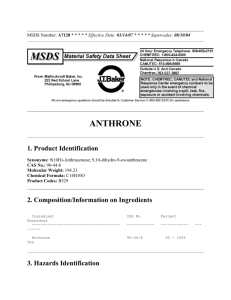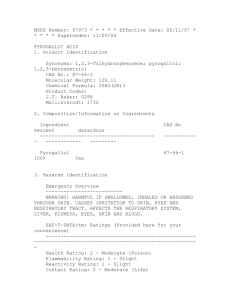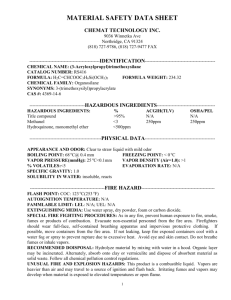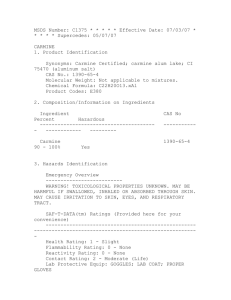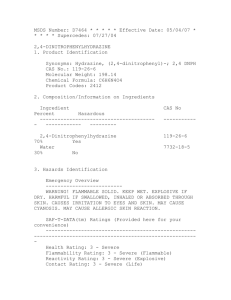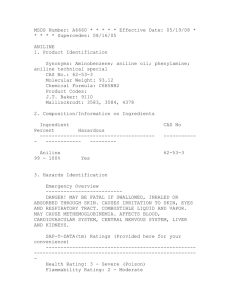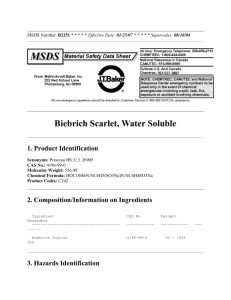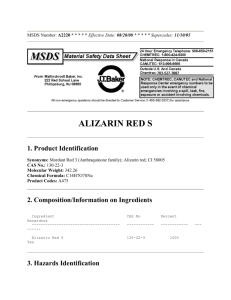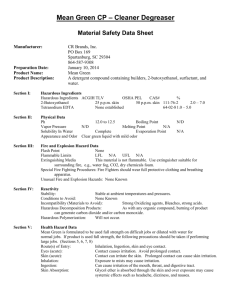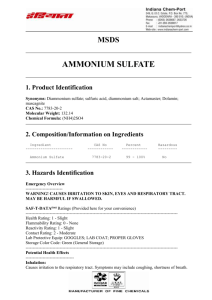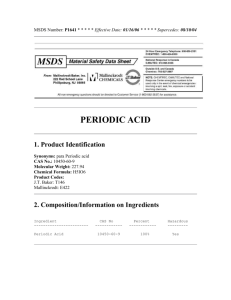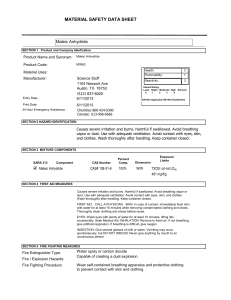MSDS Number: M7115 Effective Date: 08/10/04
advertisement
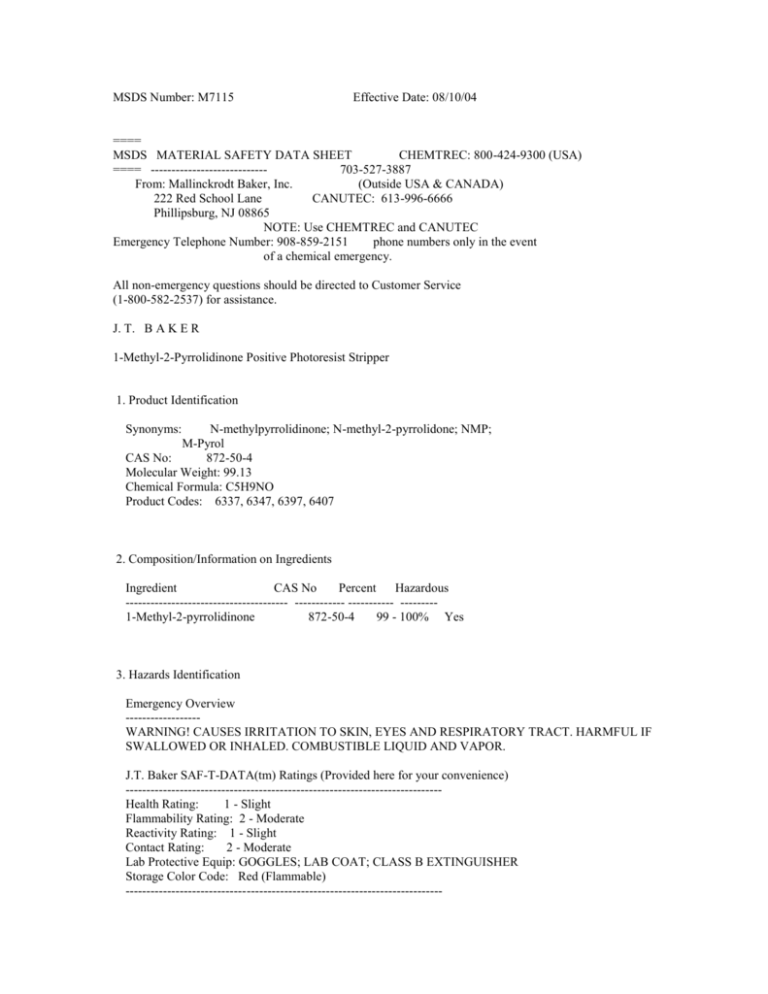
MSDS Number: M7115 Effective Date: 08/10/04 ==== MSDS MATERIAL SAFETY DATA SHEET CHEMTREC: 800-424-9300 (USA) ==== ---------------------------703-527-3887 From: Mallinckrodt Baker, Inc. (Outside USA & CANADA) 222 Red School Lane CANUTEC: 613-996-6666 Phillipsburg, NJ 08865 NOTE: Use CHEMTREC and CANUTEC Emergency Telephone Number: 908-859-2151 phone numbers only in the event of a chemical emergency. All non-emergency questions should be directed to Customer Service (1-800-582-2537) for assistance. J. T. B A K E R 1-Methyl-2-Pyrrolidinone Positive Photoresist Stripper 1. Product Identification Synonyms: N-methylpyrrolidinone; N-methyl-2-pyrrolidone; NMP; M-Pyrol CAS No: 872-50-4 Molecular Weight: 99.13 Chemical Formula: C5H9NO Product Codes: 6337, 6347, 6397, 6407 2. Composition/Information on Ingredients Ingredient CAS No Percent Hazardous --------------------------------------- ------------ ----------- --------1-Methyl-2-pyrrolidinone 872-50-4 99 - 100% Yes 3. Hazards Identification Emergency Overview -----------------WARNING! CAUSES IRRITATION TO SKIN, EYES AND RESPIRATORY TRACT. HARMFUL IF SWALLOWED OR INHALED. COMBUSTIBLE LIQUID AND VAPOR. J.T. Baker SAF-T-DATA(tm) Ratings (Provided here for your convenience) ---------------------------------------------------------------------------Health Rating: 1 - Slight Flammability Rating: 2 - Moderate Reactivity Rating: 1 - Slight Contact Rating: 2 - Moderate Lab Protective Equip: GOGGLES; LAB COAT; CLASS B EXTINGUISHER Storage Color Code: Red (Flammable) ---------------------------------------------------------------------------- Potential Health Effects -----------------------Inhalation: Mild irritant if vapor or mist from heated solvent is inhaled. Coughing, possible breathing difficulties may be observed. Ingestion: Causes irritation to the gastrointestinal tract. Symptoms may include nausea, vomiting and diarrhea. Skin Contact: Mild irritant, may cause some discomfort if in contact with the skin for several hours. Eye Contact: Causes irritation, redness, and pain. May possibly cause corneal clouding. Chronic Exposure: Minor skin irritation on repeated contact. Aggravation of Pre-existing Conditions: No information found. 4. First Aid Measures Inhalation: Remove to fresh air. If not breathing, give artificial respiration. If breathing is difficult, give oxygen. Get medical attention. Ingestion: Induce vomiting immediately as directed by medical personnel. Never give anything by mouth to an unconscious person. Get medical attention. Skin Contact: Immediately flush skin with plenty of water for at least 15 minutes. Remove contaminated clothing and shoes. Get medical attention. Wash clothing before reuse. Thoroughly clean shoes before reuse. Eye Contact: Immediately flush eyes with plenty of water for at least 15 minutes, lifting lower and upper eyelids occasionally. Get medical attention immediately. 5. Fire Fighting Measures Fire: Flash point: 93C (199F) CC Autoignition temperature: 346C (655F) Flammable limits in air % by volume: lel: 0.99; uel: 3.9 Combustible. Explosion: Above the flash point, explosive vapor-air mixtures may be formed. Fire Extinguishing Media: Dry chemical, foam or carbon dioxide. Special Information: In the event of a fire, wear full protective clothing and NIOSH-approved self-contained breathing apparatus with full facepiece operated in the pressure demand or other positive pressure mode. 6. Accidental Release Measures Ventilate area of leak or spill. Remove all sources of ignition. Wear appropriate personal protective equipment as specified in Section 8. Isolate hazard area. Keep unnecessary and unprotected personnel from entering. Contain and recover liquid when possible. Use non-sparking tools and equipment. Collect liquid in an appropriate container or absorb with an inert material (e. g., vermiculite, dry sand, earth), and place in a chemical waste container. Do not use combustible materials, such as saw dust. Do not flush to sewer! J. T. Baker SOLUSORB(R) solvent adsorbent is recommended for spills of this product. 7. Handling and Storage Keep in a tightly closed container. Store in a cool, dry, ventilated area away from sources of heat or ignition. Protect against physical damage. Store separately from reactive or combustible materials, and out of direct sunlight. Containers of this material may be hazardous when empty since they retain product residues (vapors, liquid); observe all warnings and precautions listed for the product. 8. Exposure Controls/Personal Protection Airborne Exposure Limits: AIHA Workplace Environmental Exposure Level (WEEL):10 ppm, 8-hour, TWA Ventilation System: A system of local and/or general exhaust is recommended to keep employee exposures below the Airborne Exposure Limits. Local exhaust ventilation is generally preferred because it can control the emissions of the contaminant at its source, preventing dispersion of it into the general work area. Please refer to the ACGIH document, "Industrial Ventilation, A Manual of Recommended Practices", most recent edition, for details. Personal Respirators (NIOSH Approved): For conditions of use where exposure to the substance is apparent and engineering controls are not feasble, consult an industrial hygienist. For emergencies, or instances where the exposure levels are not known, use a full-facepiece positive-pressure, air-supplied respirator. WARNING: Air purifying respirators do not protect workers in oxygen-deficient atmospheres. Skin Protection: Wear impervious protective clothing, including boots, gloves, lab coat, apron or coveralls, as appropriate, to prevent skin contact. Eye Protection: Use chemical safety goggles and/or a full face shield where splashing is possible. Maintain eye wash fountain and quick-drench facilities in work area. 9. Physical and Chemical Properties Appearance: Clear, colorless liquid. Odor: Slight amine odor. Boiling Point: 202C (396F) Melting Point: -24C (-11F) Solubility: Miscible in water. Vapor Density (Air=1): 3.4 Specific Gravity: 1.03 Vapor Pressure (mm Hg): 0.5 @ 25C (77F) pH: 7.7 Evaporation Rate (BuAc=1): 0.06 % Volatiles by volume @ 21C (70F): 100 10. Stability and Reactivity Stability: Stable under ordinary conditions of use and storage. Hygroscopic and basic. Hazardous Decomposition Products: Burning may produce carbon monoxide, carbon dioxide, nitrogen oxides. Hazardous Polymerization: Will not occur. Incompatibilities: Strong oxidants and acids. Reacts with chlorinating agents to form the amide. Reacts with sulfur or carbon disulfide at high temperatures and pressures. Conditions to Avoid: Heat, flames, ignition sources and incompatibles. 11. Toxicological Information 1-Methyl-2-pyrrolidinone: Oral rat LD50: 3914 mg/kg; Skin rabbit LD50: 8 gm/kg; Investigated as a mutagen, reproductive effector. Investigated as a mutagen, reproductive effector. --------\Cancer Lists\--------------------------------------------------------NTP Carcinogen--Ingredient Known Anticipated IARC Category ------------------------------------ ----- ----------- ------------1-Methyl-2-pyrrolidinone (872-50-4) No No None 12. Ecological Information Environmental Fate: When released into the soil, this material may biodegrade to a moderate extent. When released into the soil, this material may evaporate to a moderate extent. When released into water, this material is not expected to evaporate significantly. This material is not expected to significantly bioaccumulate. When released into the air, this material is expected to be readily degraded by reaction with photochemically produced hydroxyl radicals. When released into the air, this material may be removed from the atmosphere to a moderate extent by wet deposition. Environmental Toxicity: The LC50/96-hour values for fish are over 100 mg/l. 13. Disposal Considerations Whatever cannot be saved for recovery or recycling should be managed in an appropriate and approved waste disposal facility. Processing, use or contamination of this product may change the waste management options. State and local disposal regulations may differ from federal disposal regulations. Dispose of container and unused contents in accordance with federal, state and local requirements. 14. Transport Information Not regulated. 15. Regulatory Information --------\Chemical Inventory Status - Part 1\-------------------------------Ingredient TSCA EC Japan Australia ----------------------------------------------- ---- --- ----- --------1-Methyl-2-pyrrolidinone (872-50-4) Yes Yes Yes Yes --------\Chemical Inventory Status - Part 2\---------------------------------Canada-Ingredient Korea DSL NDSL Phil. ----------------------------------------------- ----- --- ---- ----1-Methyl-2-pyrrolidinone (872-50-4) Yes Yes No Yes -------\Federal, State & International Regulations - Part 1\----------------SARA 302- ------SARA 313-----Ingredient RQ TPQ List Chemical Catg. ---------------------------------------- --- ----- ---- -------------1-Methyl-2-pyrrolidinone (872-50-4) No No Yes No --------\Federal, State & International Regulations - Part 2\---------------RCRA- -TSCAIngredient CERCLA 261.33 8(d) ----------------------------------------- ------ ------ --1-Methyl-2-pyrrolidinone (872-50-4) No No No Chemical Weapons Convention: No TSCA 12(b): Yes CDTA: No SARA 311/312: Acute: Yes Chronic: No Fire: No Pressure: No Reactivity: No (Pure / Liquid) Prop 65: THIS PRODUCT CONTAINS A CHEMICAL(S) KNOWN TO THE STATE OF CALIFORNIA TO CAUSE BIRTH DEFECTS OR OTHER REPRODUCTIVE HARM. Australian Hazchem Code: None allocated. Poison Schedule: None allocated. WHMIS: This MSDS has been prepared according to the hazard criteria of the Controlled Products Regulations (CPR) and the MSDS contains all of the information required by the CPR. 16. Other Information NFPA Ratings: Health: 2 Flammability: 1 Reactivity: 0 Label Hazard Warning: WARNING! CAUSES IRRITATION TO SKIN, EYES AND RESPIRATORY TRACT. HARMFUL IF SWALLOWED OR INHALED. COMBUSTIBLE LIQUID AND VAPOR. Label Precautions: Avoid contact with eyes, skin and clothing. Avoid breathing vapor or mist. Keep container closed. Use only with adequate ventilation. Keep away from heat and flame. Wash thoroughly after handling. Label First Aid: In case of contact, immediately flush eyes or skin with plenty of water for at least 15 minutes. Remove contaminated clothing and shoes. Wash clothing before reuse. If inhaled, remove to fresh air. If not breathing, give artificial respiration. If breathing is difficult, give oxygen. If swallowed, induce vomiting immediately as directed by medical personnel. Never give anything by mouth to an unconscious person. In all cases, get medical attention. Product Use: Laboratory Reagent. Revision Information: No Changes. Disclaimer: ******************************************************************************** Mallinckrodt Baker, Inc. provides the information contained herein in good faith but makes no representation as to its comprehensiveness or accuracy. This document is intended only as a guide to the appropriate precautionary handling of the material by a properly trained person using this product. Individuals receiving the information must exercise their independent judgment in determining its appropriateness for a particular purpose. MALLINCKRODT BAKER, INC. MAKES NO REPRESENTATIONS OR WARRANTIES, EITHER EXPRESS OR IMPLIED, INCLUDING WITHOUT LIMITATION ANY WARRANTIES OF MERCHANTABILITY, FITNESS FOR A PARTICULAR PURPOSE WITH RESPECT TO THE INFORMATION SET FORTH HEREIN OR THE PRODUCT TO WHICH THE INFORMATION REFERS. ACCORDINGLY, MALLINCKRODT BAKER, INC. WILL NOT BE RESPONSIBLE FOR DAMAGES RESULTING FROM USE OF OR RELIANCE UPON THIS INFORMATION. ******************************************************************************** Prepared by: Environmental Health & Safety Phone Number: (314) 654-1600 (U.S.A.) M7115
